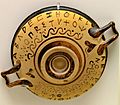Beta facts for kids
 |
|||
Quick facts for kids Greek alphabet |
|||
|---|---|---|---|
| Αα | Alpha | Νν | Nu |
| Ββ | Beta | Ξξ | Xi |
| Γγ | Gamma | Οο | Omicron |
| Δδ | Delta | Ππ | Pi |
| Εε | Epsilon | Ρρ | Rho |
| Ζζ | Zeta | Σσ | Sigma |
| Ηη | Eta | Ττ | Tau |
| Θθ | Theta | Υυ | Upsilon |
| Ιι | Iota | Φφ | Phi |
| Κκ | Kappa | Χχ | Chi |
| Λλ | Lambda | Ψψ | Psi |
| Μμ | Mu | Ωω | Omega |
| Other letters | |||
| Ϝϝ | Digamma | Ϟϟ | Koppa |
| Ϛϛ | Stigma | Ϡϡ | Sampi |
| Ͱͱ | Heta | Ϸϸ | Sho |
| Ϻϻ | San | ||
Beta (written as Β for uppercase and β for lowercase) is the second letter of the Greek alphabet. It's a very old letter with an interesting history!
In Ancient Greece, Beta was used to make a "b" sound, like in the English word "ball." But over time, the sound changed. In Modern Greek, Beta now makes a "v" sound, like in the English word "van."
Beta also has a special meaning in Greek numerals. It stands for the number 2. Many letters in our own alphabet, like the English letter B, came from Beta. The Cyrillic letter Б, used in languages like Russian, also came from Beta.
The Letter Beta's Journey
The sounds "b" and "v" are quite similar. Around 200 BC, the "b" sound that Beta made in Ancient Greek slowly changed into a "v" sound. This is why in the Cyrillic alphabet, the letter B now means the "v" sound. A new letter, called Б, was created in Cyrillic to make the "b" sound.
Beta in Science and Math
The letter Beta isn't just used in alphabets. It's also very important in many other fields, like finance, science, and mathematics.
For example, in math, there's something called the "beta function." It's named after the capital letter Β. In statistics, which is about collecting and understanding data, the lowercase β is used to show the chance of a specific type of mistake called a "type II error." This shows how a single letter can have many different uses!
Related pages
Images for kids
See also
 In Spanish: Β para niños
In Spanish: Β para niños


